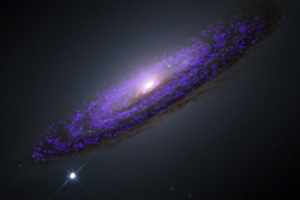Unmasking galaxies’ hidden black holes

Most galaxies have a massive black hole at their center, astronomers suspect, but only a few dozen examples are known out of billions of galaxies in the cosmos.
Now astronomers have developed a quick technique that could potentially uncover and weigh 10 times more massive black holes. Using the Combined Array for Research in Millimeter-wave Astronomy (CARMA) in California’s Owens Valley, UC Berkeley and European astronomers tracked carbon monoxide gas swirling around the center of a galaxy 53 million light years from Earth. Based on the gas’s motion, they concluded that the galaxy, NGC4526, harbored a massive black hole about 450 million times the mass of the sun – 100 times larger than the black hole at the center of our Milky Way Galaxy.
“Because almost all spiral galaxies like the Milky Way and about one-quarter of large galaxies of the type we observed have molecular gas, this interferometry technique applies broadly, and raises the real probability of getting a large sample of black holes from all sorts of galaxies at much greater distances,” said Leo Blitz, UC Berkeley professor of astronomy and coauthor of a paper describing the procedure that appeared in the Jan. 31 issue of the journal Nature.
The Atacama Large Millimeter/submillimeter Array (ALMA) now nearing completion in Chile could potentially measure black hole masses at the centers of hundreds of galaxies in as little as 10 minutes each, “shedding light on the mysterious co-evolution of black holes and galaxies,” said team leader Timothy A. Davis of the European Southern Observatory (ESO), based in Germany.
